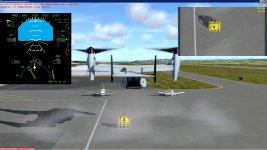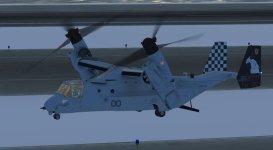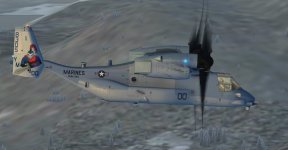Hi Guys,
I have a lot of remarks/additions on these above posts regarding sling/hoist, but I have no time right now to reply in-depth.
I'll respond in detail in a day or two.
Two things though to realise ...
1. As Microsoft defined/implemented it in FSX-Accell ( and is now in P3D).
- Sling operation: applies to a fixed cable with fixed length, hanging underneath an aircraft.
- Hoist operation: applies to a hydraulic hoist system where you can lower/raise a cable.
2. For hoist operation: if your PC doesn't visuallly show a cable (in spotplane view) where it should, or shows a cable where it shouldn't: this may be just a visual problem..
Meaning: even if the cable isn't visible in spotplane view, the hoist system might still work as intended.
All of the above posts just state the cable isn't visible; but that doesn;t mean the Hoist system isn't working functionally

Rob
Hi Mark,
I just Emailed you the Test gauge with instructions.
Please try it and let me know what happens with you ....
And in general, as to my remarks about the Hoist system implementation in FSX/P3D (apart from the cable-display problem).
I find it's implementation rather buggy resp. limited (as if the Aces team suddenly had to stop implementation because of release time-pressure) , for a number of reasons:
1. In the [Sling] section of the aircraft.cfg, you can define which Exit should be opened automatically if you extend the Hoist arm (with CTRL-U).
Which is fine.
But if you don't specify an Exit, it uses Exit-0 as default.
Meaning that it always requires one door to be opened, otherwise the Hoist system won't work.
2. The fixed concept using a Hoist arm.
This is probably correct for a Helicopter, where you should extend an Hoist arm through a sidedoor .
But makes no sense for an aircraft (like the V22) with a hoist system through bottom doors ...
3. After the Hoist arm is extended with CTRL-U, you need to give one J command (Lower cable) to set the cable to it's initial position (length becomes 0)
Which makes the cable visibly extended (1 feet or meter ?).
However, when you now retract the Hoist arm, the cable stays extended and always visible.
There is no way to visibly hide the cable again whilst in that flight ....
4. In the aircraft.cfg, you can define a payload station to which the weight of a hoisted object is added, increasing the total weight of the aircraft.
By itself, that works fine.
However, adding the object's weight shouldn't be done when
you load an attached object "into" the aircraft, but when it's attached to the hook and lifted off the ground.
So: quite unrealistic now wrt. adding weigth.
5. Definition of cable forces that will break the cable when exceeded.
Very unrealistic now.
Maybe the algoritm that calculates the cable forces works Ok by itself, but it's strongly influenced by the internal scheduling of FSX/P3D.
Meaning that if you have a sudden drop in framerate "(spyke) for whatever reason (scenery loading, opening a new window, or whatever cause), the cable might break.
EVEN if the weight of the attached object (as defined in it's sim.cfg) is only a few pounds.
What's missing: a way to disable the cable breaking; like with disabling "CrashDetection" in FSX/P3D.
In short:
Am I blaming MS for such a crummy implementation of a Hoist system in FSX (and therewith: P3D) ?
NO, it's just what it is. And I have had (and still have) a lot of fun with it, as long as one realises these "limitations" and accept them.
It's just a matter of "expectations", and that's where I am disappointed.
Because the "quality" of realisme of this Hoist system implementation is nowhere near the quality of the sim in most other aspects.
And worse: there's no way of programming around these limitations , because it's all hard-coded in the sim (FSX/P3D).
Cheers, Rob





